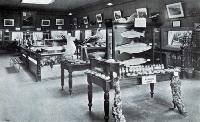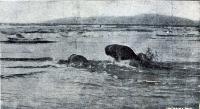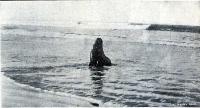Natural History Exhibits
- Displays of birds, fish, and other creatures at the Exhibition helped fulfil one of its aims, which was to be an educational experience for visitors.
- Visitors to the Natural History Court, Aviary, and Aquarium were able to view rare birds and animals that they would not usually have had access to, many of which were native to New Zealand.
Native Fauna
In the northern end of the gallery of the Main Building was the Natural History Court, where there was a large display of stuffed specimens of New Zealand native birds, all loaned by the Otago Museum. Among the birds displayed were the moa, the white heron, the kea, bell-birds, tui, huia, kōkako, pūkeko, kākā, kākāpō, kiwi, the long-tailed and shining cuckoos, the godwit, various species of duck and the takahe (then thought to be extinct).
Outside the Exhibition Buildings, in a little aviary under the pine trees in the park, the Natural History Committee had collected a number of live New Zealand birds, including the flightless Auckland Islands duck (one of New Zealand’s rarest birds) and the tuatara lizard. After the Exhibition, the tuatara and some of the ducks were given to the North Canterbury Acclimatisation Society to display in its enclosure in Hagley Park.
Aquarium
The Aquarium occupied a detached building near the edge of Victoria Lake. Several small reservoirs surrounded the outside of the building, and contained different species of live trout, salmon, perch, gold fish, American cat fish, and eels. Inside was a large tank of brown and rainbow trout, and a fish hatchery plant. There were also displays of mounted fish, including species from America and England.
Subantarctic creatures
In order to provide an exhibition of some of New Zealand's little-known animals,
the Government had brought from Macquarie Island, a number of seals, penguins, mollymawks (albatross) and petrels. These subantarctic creatures were collected by Captain Bollons of the Hinemoa.
The seals included a great sea-lion (named "Jumbo"), two black seals (named "Bully" and "Lady Nelly"), a brown seal and a fur-seal (named "The Sneak"). The birds and seals were kept in a pond and enclosure made by fencing off a portion of the Victoria Lakelet, and were fed and looked after by the North Canterbury Acclimatisation Society.
The penguins were of the crested and tufted species. A 13-year old boy, writing in the Star, said the display was "great, but round there is a smell enough to blind you".1 At the close of the Exhibition, the seals were liberated in the sea near the mouth of the Waimakariri River.
Ostriches
Also on display were four ostriches which had been bred by George King of Burwood. The birds, hooded with socks to keep them calm, were conveyed to Hagley Park in one of Strange’s furniture pantechnicons. During the journey, they lost many small feathers by rubbing against the walls of the vehicle and these feathers were gathered up by Māori from the Pa, who used them to decorate cloaks and piu-piu worn during their performances at the Exhibition.
![]()
Related photos
Related pages
Sources
- Cowan, J. Official record of the New Zealand International Exhibition of Arts and Industries held at Christchurch, 1906-7, pp. 160-165
- Lamb, R. C. Birds, Beasts and fishes: the first 100 years of the North Canty Acclimatisation Society. pp. 105, 123
Footnotes
- [1] "A boy’s appreciation" The Star, 4 December 1906, page 3











